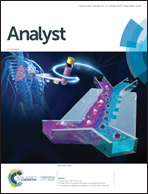A multiplexed FRET aptasensor for the simultaneous detection of mycotoxins with magnetically controlled graphene oxide/Fe3O4 as a single energy acceptor†
Abstract
Aflatoxin B1 (AFB1) and fumonisin B1 (FB1) are the most common mycotoxins and often coexist in agricultural products, and are known to form a toxic superposition and even have carcinogenic effects on humans. We propose a multiplexed fluorescence resonance energy transfer (FRET) aptasensor for the simultaneous detection of mycotoxins with magnetically controlled graphene oxide (GO)/Fe3O4 as the single energy acceptor. CdTe quantum dots emitting green (GQDs) and red (RQDs) fluorescence were modified by aptamers that are specific for AFB1 and FB1 and used as dual energy donors. Compared with conventional FRET systems based on a GO quencher, GO/Fe3O4, as a single energy acceptor, not only simultaneously quenches the different fluorescence emission peaks of the aptamer-modified GQDs and RQDs but also can be effectively removed by magnetic separation to eliminate background interference. In the absence of the GO/Fe3O4 nanocomposites, the aptamer-modified GQDs and RQDs emit strong fluorescence under ultraviolet radiation. The fluorescence of the GQDs and RQDs is quenched when the GO/Fe3O4 nanocomposites are added to the system owing to the π–π stacking interactions between the GO/Fe3O4 nanocomposites and the GQD- and RQD-labeled aptamers. However, in the presence of AFB1 and FB1, the binding of aptamers to their specific targets will fold their single stranded structures and hinder the contact between the base group in the aptamers and GO/Fe3O4, which will cause the fluorescence recovery of GQDs and RQDs. With the help of a one-step magnetic separation, the supernatants can be collected for fluorescence analysis. After the optimization of detection conditions, the developed method had a wide linear range of 10 pg mL−1–100 ng mL−1 for AFB1 and 50 pg mL−1–300 ng mL−1 for FB1 and showed no cross-reactivity with other closely related mycotoxins. The limit of detection for AFB1 and FB1 were calculated to be 6.7 and 16.2 pg mL−1 based on S/N = 3, respectively. The detection of mycotoxins was successfully realized in peanut samples, indicating the successful application of this new FRET system for various future targets.



 Please wait while we load your content...
Please wait while we load your content...